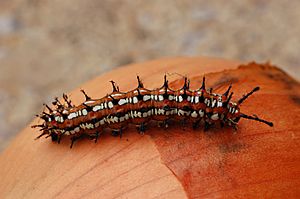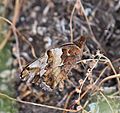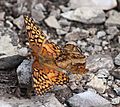Variegated fritillary facts for kids
Quick facts for kids Variegated Fritillary |
|
|---|---|
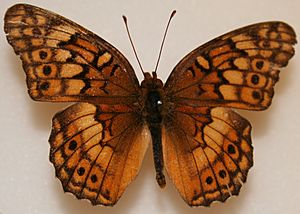 |
|
| Scientific classification | |
| Kingdom: | |
| Phylum: | |
| Class: | |
| Order: | |
| Family: | |
| Subfamily: |
Heliconiinae
|
| Genus: | |
| Species: |
E. claudia
|
| Binomial name | |
| Euptoieta claudia (Cramer, 1775)
|
|
The Variegated Fritillary (Euptoieta claudia) is a beautiful butterfly from the family Nymphalidae. You can find it naturally in North America and South America.
This butterfly is related to others in the genus Speyeria, but it has some cool differences! For example, Variegated Fritillaries can have 2-3 groups of babies (called broods) each year, while Speyeria butterflies usually only have one. They also travel a lot more instead of staying in one spot. Plus, they eat many different kinds of plants, not just violets.
One of their favorite plants to eat is passionflower. This link to passionflowers connects them to a group of butterflies called heliconians. Variegated Fritillaries fly low and super fast, making them hard to get close to. Their scientific genus name, Euptoieta, comes from a Greek word meaning "easily scared," which makes sense for such a quick butterfly!
Contents
What Does It Look Like?
The top side of the Variegated Fritillary's wings is a mix of orange and black. Both the front and back wings have a line of black spots near the edge (these are called "submarginal" spots). They also have black lines running through the middle of the wings ("median" lines).
The underside of the front wing is orange. The back wing is a mix of browns and grays, giving it a spotted or streaky look (this is called "mottled"). There's also a light-colored band just outside the middle of the wing (a "postmedian" band). Unlike some other butterflies, it doesn't have any shiny silver spots. This butterfly's wingspan is about 1.75 to 2.25 inches wide.
Similar Butterflies
There's another butterfly that looks a lot like the Variegated Fritillary: the Mexican Fritillary (Euptoieta hegesia). Here's how to tell them apart:
- The Mexican Fritillary is a brighter orange.
- The top side of its back wing has more orange color.
- The underside of its wings looks plainer, without the submarginal spots or median black lines you see on the Variegated Fritillary.
When Do They Fly?
You can see these butterflies flying at different times depending on where they live.
- In the southern parts of their range, they fly from April to October.
- In the northern areas, they fly from summer into early fall.
Where Do They Live?
The Variegated Fritillary can be found in many different places. They like open areas such as:
- Clover fields
- Alfalfa fields
- Pastures
- Waste areas
- Roadsides
- Mountain meadows
What Flowers Do They Drink From?
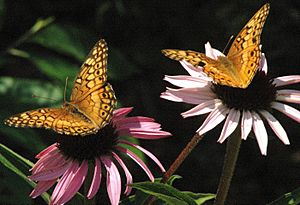
Variegated Fritillaries love to drink nectar from many kinds of flowers. Here are some of their favorites:
- Apocynum sp. - dogbane
- Asclepias syriaca - Common Milkweed
- Aster sp. - asters
- Bidens aristosa - Bearded Beggerticks
- Cirsium sp. - thistles
- Echinacea sp. - coneflowers
- Erigeron sp. - fleabane
- Eupatorium perfoliatum - Common Boneset
- Medicago sativa - Alfalfa
- Trifolium pratense - Red Clover
- Vernonia sp. - ironweed
Life Cycle
The female Variegated Fritillary lays her eggs one by one on the leaves and stems of host plants. These eggs are usually pale green or cream colored.
- Caterpillar: Once the egg hatches, a caterpillar appears! This caterpillar eats the leaves, flowers, and stems of its food plant. It's red with black stripes, and you'll often see white spots within those black stripes. It has six rows of black spines along its body and two long, club-shaped spines on its head.
- Chrysalis: After growing, the caterpillar turns into a chrysalis. This chrysalis is shiny white with small black spots. It can also have different amounts of brown markings and cool orange and gold bumps (projections).
- Adult: The adult butterflies spend the winter in warmer southern areas. Each spring and summer, they fly north. They usually have 2 to 3 broods (groups of offspring) each year.
What Plants Do Caterpillars Eat?
The caterpillars of the Variegated Fritillary eat a wide variety of plants. Here are some of the plants they like to munch on:
- Boerhaavia intermedia - Five-wing Spiderling
- Cynanchum arizonicum - Arizona Swallow-wort
- Hybanthus verticillatus - Babyslippers
- Linum australe - Southern Flax
- Linum rigidum - Stiffstem Flax
- Linum sulcatum - Grooved Yellow Flax
- Menispermum canadense - Canadian Moonseed
- Menispermum mexicanum - Mexican Moonseed
- Passiflora caerulea - Blue Passionflower
- Passiflora foetida - Foetid Passionflower
- Passiflora incarnate - Purple Passionflower
- Plantago sp. - plantain
- Podophyllum peltatum - Mayapple
- Portulaca oleracea - Common Purslane
- Turnera ulmifolia - Yellow Alder
- Sedum lanceolatum - Lance-leaf Stonecrop
- Viola bicolor - American Field Pansy
- Viola sororia - Common Blue Violet
- Viola tricolor ssp. - Heartsease
Images for kids


